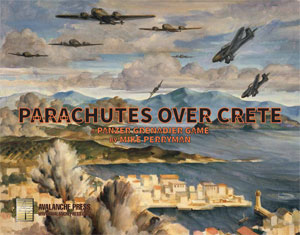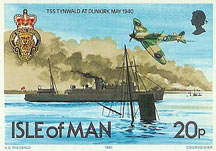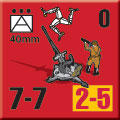Parachutes Over Crete:
The
Army of Man
By Mike Bennighof, Ph.D.
December 2022
 The babes unborn shall rue the day The babes unborn shall rue the day
That the isle of Man was sold away
Situated in the Irish Sea between Britain
and Ireland, the Isle of Man is probably best
known outside the United Kingdom as the model
for the island of Sodor (the name of one of
Man’s bishoprics) in Rev. W.V. Awdry’s
series of “Thomas the Tank Engine”
children’s books. Home to about 75,000
people today, the island was settled in early
times by Pictish tribes, and by the first
centuries of the Christian era was home to
Celtic peoples culturally close to the Irish
— St. Patrick is said to have rid Man
of snakes and reptiles just as he did Ireland
herself.
The first recorded ruler of Man, the wizard
Mannanan mac Lir, supposedly kept invaders
away with mists provided by his father, the
Celtic sea god Lir. The island still is often
mist-shrouded, and some swear to the magical
properties of these fogs, which also play
an important role in Awdry’s tales of
talking railroad equipment. Whatever the reality,
Irish missionaries Christianized Man, and
the first formal political organization came
in 582 under the Scottish rule. Man passed
to Wales in 825 and to the Viking Kingdom
of Dublin in 853. Viking kinds of York, Dublin,
the Orkneys and Norway passed sovereignty
back and forth until 1079, when Godred IV
Haraldsson the White Hands (still known in
Man as King Orry) established a quasi-independent
Kingdom of Man and the Western Isles (the
Hebrides).

Any four-year-old can put a name to
this character.
|
In 1263, the Scottish King Alexander III
attacked the Hebrides. King Magnus of Man
and King Haakon of Norway sailed to defend
them. The Scots defeated the combined Norwegian-Manx
host at Largs and in 1266 forced a peace treaty
on them that brought Man under Scottish suzerainty.
A short-lived Manx rebellion in 1275 failed
to expell the Scots.
Alexander’s death in 1286 would lead
to more troubles for Man, as England and Scotland
passed the island back and forth in the wars
that followed. Robert the Bruce conquered
the island from its English garrison in 1313
following a siege of the capital, Douglas.
Finally in 1333 Man became an English fiefdom,
separated from the Hebrides which remained
Scottish (though Manx still refer to their
island rather than Britain as “the mainland,”
to distinguish it from “the islands”).
In 1405 Henry IV granted the island’s
lordship along with the title “King
of Man” to his supporter Sir John Stanley.
Exactly a century later, Thomas III Stanley,
Sir John’s great-grandson, yielded the
royal title, claiming that he would “rather
be a great lord than a petty king.”
The lordship of the island continued in the
Stanley family — though the Manx militia
refused to fight for the Royalist cause espoused
by their lord during the English Civil War
— until that line died out in 1736 and
it passed to James Murray, Duke of Atholl.

The Manx recall their heroes.
|
Man’s special legal status meant that
local laws had to be approved by its own ancient
parliament, the Tynwall. Debts incurred elsewhere
could not be collected on the island, and
most English customs laws did not apply. The
island became a refuge for smugglers and spendthrifts,
and the crown pressured the Duke to sell off
his title and customs privileges in 1765 for
a large lump sum and sizable annuity. His
son extracted an even larger additional payment
in 1829. Since 1765 the King or Queen of England
has also been King or Queen of Man, but successive
lieutenant governors have tried in vain to
convince English monarchs to use the title
in formal proclamations.
During both World Wars, the island hosted
internment camps for enemy civilians, as well
as prisoners of war. The steam ferries that
connected the island to Britain were requisitioned
in both wars. Three of them saw action as
seaplane carriers in the Great War (Vindex,
Ben-my-Chree and Manxman) and eight
others (out of 14 total) were used as transports.
Eight of the Isle of Man Steam Packet Company’s
16 ships participated in the Dunkirk evacuation
in 1940, rescuing almost 25,000 British troops.
A Manx packet, Mona’s Isle, was
the first to bring back troops to Britain.
Ten vessels all told went into naval service,
and four of them were lost.
 The Isle of Man had a higher enlistment rate than most British counties in both wars. The Manx Regiment formed in July 1938 as the 15th (Isle of Man) Light Anti-Aircraft Regiment and armed with a variety of anti-aircraft weapons. In August 1939 the regiment’s two batteries (41 and 42) mobilized and shipped out for Liverpool to defend the Mersey docks from German air attack. A third battery (129) was raised in late August to bring the unit to the full strength of three batteries. By October the regiment had been moved to southern England and equipped solely with 40mm Bofors anti-aircraft guns. The Isle of Man had a higher enlistment rate than most British counties in both wars. The Manx Regiment formed in July 1938 as the 15th (Isle of Man) Light Anti-Aircraft Regiment and armed with a variety of anti-aircraft weapons. In August 1939 the regiment’s two batteries (41 and 42) mobilized and shipped out for Liverpool to defend the Mersey docks from German air attack. A third battery (129) was raised in late August to bring the unit to the full strength of three batteries. By October the regiment had been moved to southern England and equipped solely with 40mm Bofors anti-aircraft guns.
The Manxmen shipped out for Egypt in November 1940, where the regiment was broken up. 41 Battery fought in the East African campaign, 42 Battery defended the Suez Canal, and 129 Battery went to Crete, where it was eventually overrun by the Germans. First Battery replaced the lost 129 and the regiment became the light anti-aircraft component of 7th Armoured Division, remaining in that role for the remainder of the war.
Despite intense Manx participation in the
war effort, a case could be made that the
island never legally had been at war —
traditionally under the United Kingdom’s
unwritten constitution, laws originating in
London only apply to Man if they specifically
state this. Even under current practice, a
number of European Union regulations do not
apply to Man (though the island enjoys free trade with the EU for agricultural products), as the island is not part of the EU and its inhabitants did not vote in the 2016 Brexit referendum.
The Manx anti-aircraft troops (two troops made up a battery) are included in Panzer Grenadier: Parachutes Over Crete in their own color scheme. There’s no real reason for them to be in their own color scheme, since they act as British units for all game purposes, but we couldn’t pass up the chance to include the Army of Man in Panzer Grenadier.
You can order Parachutes over Crete right here.
Sign up for our newsletter right here. Your info will never be sold or transferred; we'll just use it to update you on new games and new offers.
Mike Bennighof is president of Avalanche Press and holds a doctorate in history from Emory University. A Fulbright Scholar and NASA Journalist in Space finalist, he has published a great many books, games and articles on historical subjects; people are saying that some of them are actually good.
He lives in Birmingham, Alabama with his wife, three children, and new puppy. He misses his lizard-hunting Iron Dog, Leopold.
Want to keep Daily Content free of third-party ads? You can send us some love (and cash) through this link right here.
| 